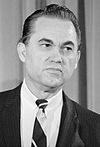
Executive Order 11111 is an executive order signed by President of the United States John F. Kennedy on 11 June 1963. It was signed to prevent the Governor of Alabama George Wallace preventing integration of schooling in Alabama.[1] The act also authorised the Secretary of Defense to federalize the Alabama National Guard.[2]
History edit
On 11 June 1963, Governor Wallace stood in the door of Foster Auditorium of the University of Alabama in Tuscaloosa to prevent black students from registering for classes in what became known as the Stand in the Schoolhouse Door. President Kennedy had issued a presidential proclamation demanding that Wallace stepped aside but had the text of the future Executive Order 11111 prepared in case Wallace did not comply.[3] The Deputy Attorney General of the United States Nicholas Katzenbach telephoned President Kennedy and told him of Wallace's actions in ignoring the proclamation as it had no legal force.[4] In response, Kennedy issued Executive Order 11111 authorizing the federalization of the Alabama National Guard.[5] Four hours later, Guard General Henry V. Graham announced the Executive Order to Wallace stating, "Sir, it is my sad duty to ask you to step aside under the orders of the President of the United States."[6] Wallace recognising what had happened made one final speech dennouncing violence and Kennedy's action[7] but eventually stepped aside.[6] Executive Order 11111 was also used to ensure that the Alabama National Guard made sure that black students across the state were able to enroll at previously all-white schools.[8]
In the days following the enactment, the National Guard were ordered to remain on the campus owing to a large Klu Klux Klan contingent in the surrounding area. Wallace and Kennedy exchanged volatile telegrams over it.[9] Wallace objected to Kennedy ordering the Guard to remain on the campus and said that Kennedy bore responsibility if something happened.[9] Kennedy responded stating that Executive Order 11111 made it clear that responsibility for keeping the peace remained with the State Troopers under Wallace's control and said he would revoke the order if assurances were made.[9] Wallace refused stating he would not be intimidated and cited that Executive Order 11111 was passed without his knowledge.[9]
Executive Order 11111 remained in force and in September was complimented by Executive Order 11118.[10] Despite succeeding in its objectives, Executive Order 11111 was not revoked.[1]
Full Text edit
WHEREAS on June 11, 1963, I issued Proclamation No. 3542, pursuant in part to the provisions of section 334 of Title 10, United States Code; and WHEREAS the commands contained in that Proclamation have not been obeyed, and the unlawful obstructions of justice and combinations referred to therein continue:
NOW, THEREFORE, by virtue of the authority vested in me by the Constitution and laws of the United States, including Chapter 15 of Title 10 of the United States Code, particularly sections 332, 333 and 334 thereof, and section 301 of Title 3 of the United States Code, it is hereby ordered as follows:
SECTION 1. The Secretary of Defense is authorized and directed to take all appropriate steps to remove obstructions of justice in the State of Alabama, to enforce the laws of the United States within that State, including the orders of the United States District Court for the Northern District of Alabama referred to in the said Proclamation, and to suppress unlawful assemblies, combinations, conspiracies and domestic violence which oppose or obstruct the execution of the laws of the United States or impede the course of justice under those laws within that State.
SEC. 2. In furtherance of the authorization and direction contained in section 1 hereof, the Secretary of Defense is authorized to use such of the Armed Forces of the United States as he may deem necessary.
SEC. 3. I hereby authorize and direct the Secretary of Defense to call into the active military service of the United States, as he may deem appropriate to carry out the purposes of this order, any or all of the units of the Army National Guard and of the Air National Guard of the State of Alabama to serve in the active military service of the United States for an indefinite period and until relieved by appropriate orders. In carrying out the provisions of section 1, the Secretary of Defense is authorized to use the units, and members thereof, called into the active military service of the United States pursuant to this section.
SEC. 4. The Secretary of Defense is authorized to delegate to the Secretary of the Army or the Secretary of the Air Force, or both, any of the authority conferred upon him by this order.
JOHN F. KENNEDY THE WHITE HOUSE, June 11, 1963[2]
References edit
- ^ a b "Executive Orders Disposition Tables". National Archives. Retrieved 2017-05-11.
- ^ a b . Washington DC. 1963 – via Wikisource.
{{citation}}: CS1 maint: location missing publisher (link) - ^ Willis, Jim (2015). 1960s Counterculture: Documents Decoded: Documents Decoded. ABC-CLIO. p. 82. ISBN 978-1610695237.
- ^ "Executive Order 10730: Little Rock Nine: Integration of the University of Alabama". Shmoop. Retrieved 2017-05-11.
- ^ "JFK faces down defiant governor - Jun 11, 1963". History Channel. Retrieved 2017-05-11.
- ^ a b Lesher, Stephan (1995). George Wallace: American Populist. Da Capo Press. p. 233. ISBN 9780201407983.
- ^ "Alabama Admits Negro Students; Wallace Bows to Federal Force; Kennedy Sees 'Moral Crisis' in U.S". New York Times. 1963-06-12. Retrieved 2017-05-11.
- ^ "Kennedy federalized National Guard to integrate Alabama public schools (Sept. 10, 1963)". AL.com. Retrieved 2017-05-11.
- ^ a b c d "Dueling Telegrams: 1963 verbal power play between Wallace and JFK" (Document). Alabama State Archives.
{{cite document}}: Unknown parameter|accessdate=ignored (help); Unknown parameter|url=ignored (help) - ^ United States General Accounting Office (1965). Decisions of the Comptroller General of the United States. Vol. 43. U.S. Government Printing Office. p. 296.